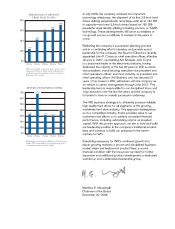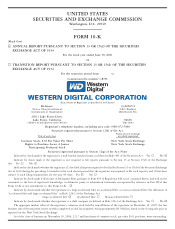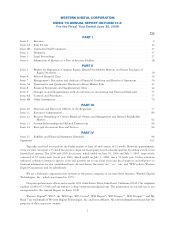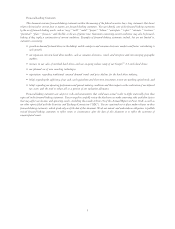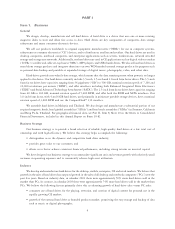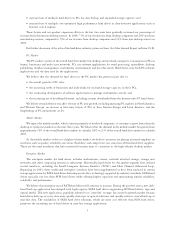Western Digital 2006 Annual Report Download - page 15
Download and view the complete annual report
Please find page 15 of the 2006 Western Digital annual report below. You can navigate through the pages in the report by either clicking on the pages listed below, or by using the keyword search tool below to find specific information within the annual report.The number of disks and each disk’s areal density, which is a measure of the amount of data that can be stored on the
recording surface of the disk, determines storage capacity of the hard drive. The higher the areal density, the more information
can be stored on a single platter. Achieving a given drive capacity requires fewer disks as the areal density increases, potentially
reducing product costs over time through reduced component requirements. Beginning in July 2006, we began shipping
3.5-inch hard drives with 160 GB per platter areal density and 2.5-inch hard drives with 80 GB per platter areal density.
Head technology is one of the variables affecting areal density. Historically, there have been rapid technological changes
resulting in several generations of head technology in a relatively short time. However, in recent years the time has lengthened
between changes in generations of head technology. Currently, the desktop hard drive industry uses giant magnetoresistive
(including tunneling magnetoresistive) head technology, which allows significantly higher storage capacities than the
previously utilized thin-film head technology. Most of our hard drive product offerings currently employ giant magneto-
resistive head technology. Additionally, we have undertaken significant development efforts to implement perpendicular
recording technology and we began using perpendicular recording heads in certain products beginning in July 2006.
The WD product line generally leverages a common platform for various products within product families with
different capacities to serve differing market needs. This platform strategy results in commonality of components across
different products within product families and, in some cases, across product families, which reduces exposure to changes
in demand, facilitates inventory management and allows us to achieve lower costs through purchasing economies. This
platform strategy also enables our customers to leverage their qualification efforts onto successive product models.
In addition to the development of hard drives, we also invest considerable resources in the development of WD head
technology used in the majority of our hard drive products. The design and manufacturing of WD heads consists of
engineering and fabricating a read element for reading data from a disk, a write element for writing data to a disk, and
slider. The slider functions similar to an airplane wing and allows the read and write elements to fly over the surface of the
disk and to land, on either the disk or a special ramp, when power is not applied to the hard drive.
Fiscal 2006 represented the fourth consecutive year of substantial growth in our research and development and
capital spending to support our significant broadening of our product and technology portfolios. Over that four-year
period, we have grown our investment spending over 250% from $168 million in fiscal 2002 to approximately
$600 million in fiscal 2006. As a result of this investment activity, we continue to expand our business beyond the
desktop market into newer markets or markets in which we have not previously participated. Such investments have
allowed us to execute against our strategic objective of revenue diversification to address the growth of new applications
for hard drives and fast-growing new market opportunities.
For an additional discussion of risks related to technological innovations, see Item 1A of this Annual Report on
Form 10-K.
Sales and Distribution
We sell our products globally to OEMs, distributors and retailers. OEMs purchase our hard drives and assemble
them into the computer or other CE systems they build. Distributors typically sell our hard drives to non-direct
customers such as small computer and CE manufacturers, dealers, systems integrators, online retailers and other resellers.
Retailers typically sell our hard drive products directly to end-users.
Original Equipment Manufacturers
Sales to OEMs accounted for 54%, 58% and 51% of our revenue in 2006, 2005 and 2004, respectively. During
2006, our major OEM customer was Dell. During 2006, 2005 and 2004, sales to Dell accounted for 12%, 16%, and
14%, respectively, of our revenue. We believe that our success depends on our ability to maintain and improve our strong
relationships with the leading OEMs.
OEMs evaluate and select their hard drive suppliers based on a number of factors, including quality and reliability,
storage capacities, performance characteristics, price, service and support, ease of doing business, and the supplier’s long-
term financial stability. They typically seek to qualify two or more providers for each generation of hard drives, and once
an OEM has chosen its qualified hard drive vendors for a given product, it generally will purchase hard drives from those
vendors for the life of that product. To achieve success with OEM qualifications, a hard drive supplier must consistently
offer hard drives featuring leading technology, quality, and reliability at acceptable capacity per disk. Suppliers must
9


